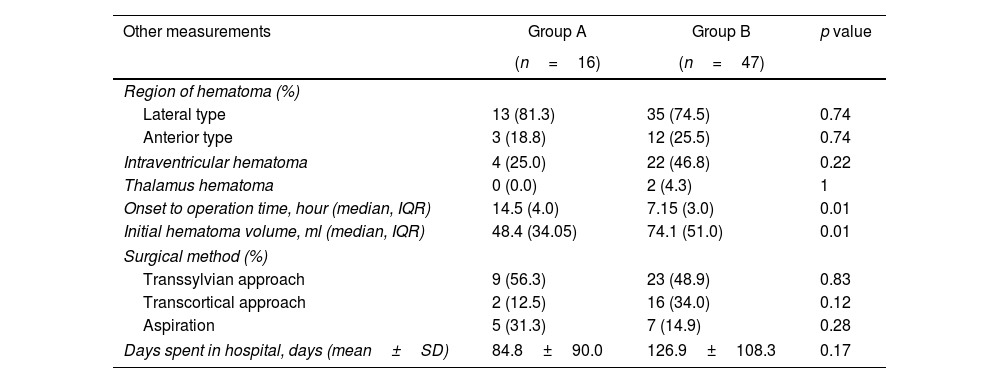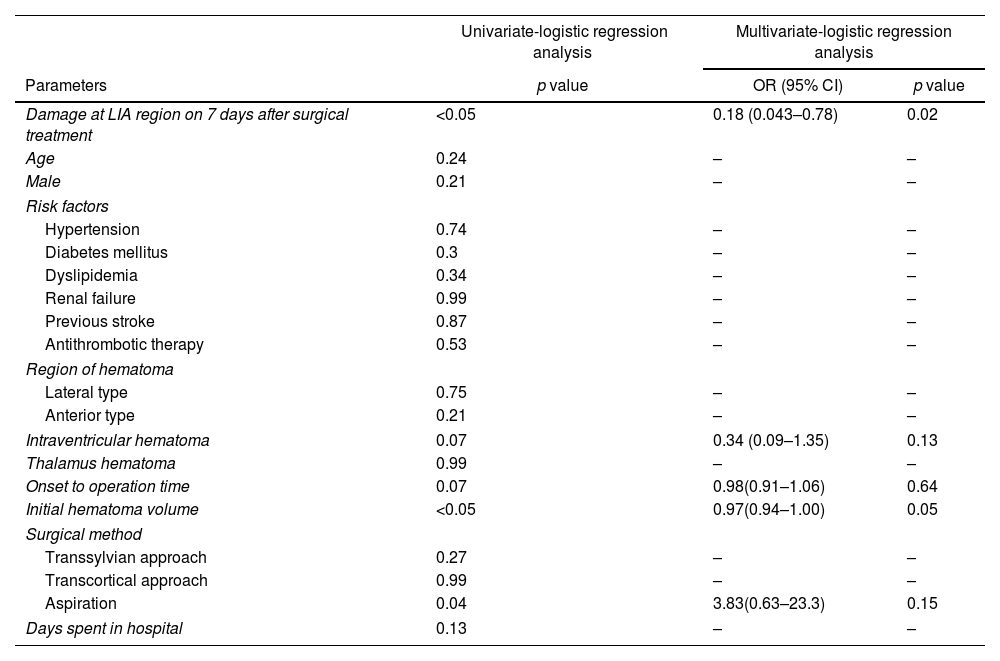Although the putamen is the most common area of spontaneous intracerebral hemorrhage, previous reports about the effects of surgery are limited. We sometimes experience a poor prognosis in patients in whom there is no damage to the internal capsule, but with injury in the long insular artery (LIA) region. The purpose of this study was to confirm the relationship between LIA damage and patient prognosis following surgery for putaminal hemorrhage.
MethodsWe retrospectively collected data of 287 surgical cases who presented with putaminal hemorrhage between January 2004 and March 2022. Among them, we chose patients without initial damage to the posterior limb of the internal capsule, and divided these patients into two groups, those without (Group A) and with (Group B) final damage in the LIA region. We compared positivity rates of final manual muscle test (MMT) scores≥3 and related factors.
ResultsSixty-three of the 287 patients were included in this study. Of them, 11 cases in Group A were positive for MMT scores≥3 (68.8%) and 9 cases (19.1%) in Group B had MMT scores≥3 seven days after surgery. Group A thus had a significantly higher rate of MMT scores≥3 than group B (p=0.00).
ConclusionIn patients without initial damage to the internal capsule, LIA injury might be a key sign for predicting the functional prognosis of putaminal hemorrhage.
Aunque el putamen es la zona más común de la hemorragia intracerebral espontánea, los informes previos sobre los efectos de la cirugía son limitados. En ocasiones se observa un mal pronóstico en los pacientes en los que no hay daño en la cápsula interna, pero sí en la región de la arteria insular larga (AIL). El propósito de este estudio fue confirmar la relación entre el daño de la AIL y el pronóstico de los pacientes tras la cirugía de la hemorragia putaminal.
MétodosSe recogieron retrospectivamente los datos de 287 casos quirúrgicos que se presentaron con hemorragia putaminal entre enero de 2004 y marzo de 2022. Entre ellos, elegimos a los pacientes sin daño inicial en la extremidad posterior de la cápsula interna, y dividimos a estos pacientes en 2 grupos, los que no tenían (grupo A) y los que tenían (grupo B) daño final en la región AIL. Se compararon las tasas de positividad de las puntuaciones finales de la prueba muscular manual (TMM)≥3 y los factores relacionados.
ResultadosSesenta y tres de los 287 pacientes fueron incluidos en este estudio. De ellos, 11 casos del grupo A tuvieron puntuaciones de MMT≥3 positivas (68,8%) y 9 casos (19,1%) del grupo B tuvieron puntuaciones de MMT≥3, 7 días después de la cirugía. Así pues, el grupo A tuvo una tasa significativamente mayor de puntuaciones MMT≥3 que el grupo B (p=0,00).
ConclusiónEn los pacientes sin daño inicial en la cápsula interna, la lesión del AIL podría ser un signo clave para predecir el pronóstico funcional de la hemorragia putaminal.
Article

If it is the first time you have accessed you can obtain your credentials by contacting Elsevier Spain in suscripciones@elsevier.com or by calling our Customer Service at902 88 87 40 if you are calling from Spain or at +34 932 418 800 (from 9 to 18h., GMT + 1) if you are calling outside of Spain.
If you already have your login data, please click here .
If you have forgotten your password you can you can recover it by clicking here and selecting the option ¿I have forgotten my password¿.













